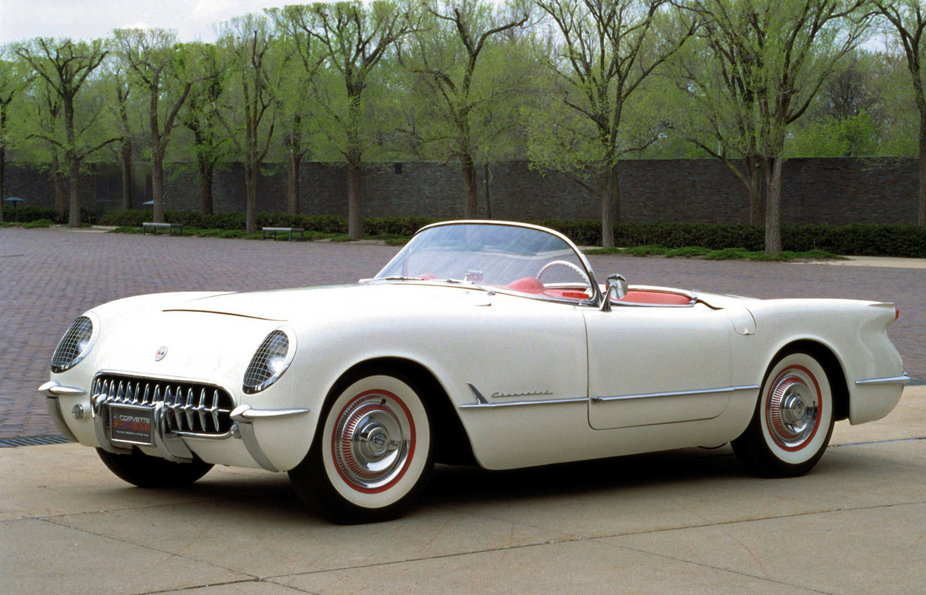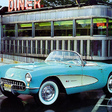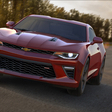|
Send this page to a friend! Fill in the form bellow | ||
news
Corvette Celebrates 60 Years as the American Sports Car
When the Chevrolet ChevroletUnited States of America, 1911 > present82 models
ChevroletUnited States of America, 1911 > present82 models
3556 photos
7 videos
Corvette Chevrolet CorvetteUnited States of America, 1953 > present7 series
Chevrolet CorvetteUnited States of America, 1953 > present7 series
137 versions
552 photos
2 videos
was introduced in 1953, no one would have imagined that the car would become the performance icon that it is today. The original cars had a 3.9 liter inline-six engine with 150hp and only available with a two-speed Powerglide automatic transmission. It was not until the introduction of the V8 in the Corvette in 1955 when it finally became the performance car that we know it as today. Next year is the 60th anniversary of the Corvette, and Chevrolet is planning on introducing the 7th generation car for its birthday.
An American Sports Car

The cover of the 1954 Corvette brochure
General Motors design guru Harley Earl penned the Corvette with the idea of competing with foreign sports cars that were becoming popular in the post-war US. Soldiers had returned home from the war seeing small, nimble cars in Europe and especially Britain. The US was having a second industrial revolution, salaries were growing and there was a pent up demand for all cars. Former soldiers began importing cars from MG MGUnited Kingdom, 1924 > present37 models
MGUnited Kingdom, 1924 > present37 models
162 photos
, Triumph TriumphUnited Kingdom, 1885 > 198430 models
TriumphUnited Kingdom, 1885 > 198430 models
40 photos
, Morgan MorganUnited Kingdom, 1909 > present12 models
MorganUnited Kingdom, 1909 > present12 models
142 photos
1 video
and many others. The concept for the Corvette called the EXP-122 was displayed in January 1953, and the first cars went on sale in late 1953.
Chevrolet sold 300 Corvettes Chevrolet CorvetteUnited States of America, 1954 > present1 photo
Chevrolet CorvetteUnited States of America, 1954 > present1 photo
in 1953 because it was still working on producing its cars and their novel fiberglass bodies. Fit and finish was a major issue at first. The 1953 Corvette had no side windows, no external door pulls and a basic, black cloth top. All 1953 cars came in Polo White with a red interior and black top. They sold for $3,490 with no factory-available options. That is equivalent to $30,039 in current American dollars, according to the US Bureau of Labor Statistics.

The 1953 and 1954 Corvette lacked door handles or windows
The first full year of Corvette production was 1954, and 3,460 cars were built but only 2,780 were sold. The car received poor reviews when released in 1953 for the anemic engine and poor quality and it affected sales in 1954. Three more colors were added in addition to Polo White: Pennant Blue, Sportsman Red, and Black.
While Ford FordUnited States of America, 1903 > present92 models
FordUnited States of America, 1903 > present92 models
2522 photos
11 videos
began building the Thunderbird![Thunderbird Gen.1 [I] Thunderbird Gen.1 [I]](/img/series/20/ford_thunderbird_gen_1_i__sqr112_1820.jpg) Ford Thunderbird Gen.1 [I]United States of America, 1954 > 19573 versions
Ford Thunderbird Gen.1 [I]United States of America, 1954 > 19573 versions
41 photos
in 1955 to compete directly against the Corvette, the Corvette owes its existence to the T-Bird. The poor sales of the car had GM ready to cancel it as a failed experiment. Corvette engineer Zora Arkos Duntov wrote a letter to Chevrolet General Manager Ed Cole saying that the company could not cancel the Corvette because it would be admitting public defeat to Ford to the public. The letter worked, and in 55, the Corvette finally began to show its performance ability.
The 1955 Corvette was the first available with the optional 4.3l V8 with 195hp and an available three-speed manual transmission. Sales of the Corvette were floundering though. It sold 700 units that year compared to 16,155 units of the new Thunderbird. However, the car finally got roll-up windows, door handles and a redesign.
For 1956, Chevrolet laid all of its cards on the table, and the Corvette Chevrolet CorvetteUnited States of America, 1956 > present1 photo
Chevrolet CorvetteUnited States of America, 1956 > present1 photo
was finally turned into a performance car. The V8 and three-speed were standard. There was a new body on the sale platform with a better top and power option; power was bumped to 210hp. A 240hp engine with the same 4.3l V8 with a hotter cam was optionally available but not many were sold. Sales jumped back up to 3,467 units, and the base price was down to $2,900 ($24,502 today).
Chevrolet revised the styling of the Corvette Chevrolet CorvetteUnited States of America, 1958 > present1 photo
Chevrolet CorvetteUnited States of America, 1958 > present1 photo
platform again for 1958 adding quad headlights. It is also the point where Corvette specifications become very complicated. Chevrolet offered the 4.3l V8 and 4.6l V8 with optional fuel injection and the options list exploded. Engines were available with 230hp, 250hp or 290hp.
Motor Trend tested a 1959 4.6l V8 Corvette against a 1959 Porsche 356 Porsche 356CGermany, 1963 > 19663 photos
Porsche 356CGermany, 1963 > 19663 photos
convertible in its April 1959 issue. The Corvette was actually more expensive at $4,375 versus $3,745 for the Porsche. The Corvette was also massively more powerful with 250hp compared to 70hp from the Porsche. The magazine praised the Porsche’s build quality and ergonomics, but it obviously could not match the Corvette’s speed.
“Firmly suspended, as good handling sports cars should be, these two cars vary considerably in riding qualities. The Corvette rides harshly with a substantial amount of pitch and chop on rough roads. The same routes are gobbled up by the Porsche’s four-wheel-independent suspension with a minimum amount of shock transmitted to driver and passenger,” said Motor Trend.
The 1962s are generally considered the ultimate first generation Corvette. It has little chrome, and the only available engine was a new 5.4l V8. It was available in 250hp, 300hp and 340hp tunes, and the optional fuel injection brought power up to 360hp. These cars were the most expensive Corvettes offered to that point at $4,038 to start ($30,728 today), but it was the best selling of the first-gen cars with 14,531 sold.
The Shark Takes a Bite

The second generation Corvette was among the great designs of the 60s
In 1961, Chevrolet showed the XP-755 Mako Shark Chevrolet Mako Shark ConceptUnited States of America, 1961 > 19613 photos
Chevrolet Mako Shark ConceptUnited States of America, 1961 > 19613 photos
concept designed by Bill Mitchell. It was long, sleek and painted so go from silver at the bottom to deep blue at the top. From the A-pillar back, the design basically became the second generation Corvette in 1963. The design had a shorter wheelbase than the first generation car and was meant to be a coupe from the start giving better aerodynamics.
Mitchell had incorporated a split rear window that is the 1963 Corvette's Chevrolet Corvette Sting ...United States of America, 1963 > present2 photos
Chevrolet Corvette Sting ...United States of America, 1963 > present2 photos
most iconic feature, but it was more expensive to produce and made it harder to see out the rear. There is some disagreement whether head engineer on the Corvette Zora Arkos Duntov and Mitchell compromised that it would be a one-year only feature or if Duntov simply removed the split window for 1964. Regardless, it has made the 1963 one of the most collectible Corvette model years.
Duntov pushed hard for the second-generation car to have an independent rear suspension and disc brakes, which was quite novel at the time. Major sports cars like Aston Martin and Ferrari still had live rear axles. He promised that it would make the car better and increase sales. Duntov got his way.

The Mako concept in 1961 showed the second generation
The 1963 Corvette went on sale in October 1962 badged as the Corvette Sting Ray. The engines were the same as 1962 but handling was significantly better. Sales jumped to 22,229 cars. The base price was down a dollar to $4,037.
Engines for the Corvette got big upgrades in 1965 and 1966. For 65, the 6.5 liter V8 became optional with 425hp. It was replaced in 66 with an optional 7.0 liter V8 that had the same 425hp but torque was up from 415lb-ft in the 6.5l to 460lb-ft in the 7.0 liter.
Motor Trend tested the 427 cubic inch (7.0 liter) V8 in the Corvette Chevrolet Corvette Sting ...United States of America, 1966 > present2 photos
Chevrolet Corvette Sting ...United States of America, 1966 > present2 photos
in its March 1966 issue. It said: “The 427 has the kind of torque that made World War II fighter planes try to wrap themselves around the propeller on takeoff. In the relatively light, frontend-heavy Corvette this verve tends to pave the highway with your rear-tire treads.”
Motor Trend complained about lack of grip and poor fuel economy of 8mpg and 12mpg while cruising. However, they praised the car’s disc brakes as world class and recorded a 0-60mph time of 5.6 seconds with two people on board.
For 1967, the second-generation Corvette's last year, the 7.0 liter received a 430hp power option that was essentially a racing motor for the road. Called the L88, it was never really meant for mere mortals. While advertised with 430hp, actual horsepower was closer to 550hp. The engine would run poorly on anything less than 102 octane, idled poorly and would overheat at low speeds. Chevrolet sold a total of 276 L88 Corvettes from 1967 to 1969.
In February 1986, Road and Track tested a 69 L88 Corvette on radial tires against a 1986 Corvette and found that it would cover the quarter mile 14.1 seconds compare to 14.4 seconds for the 1986.
The Ship Takes on Water

The third generation was basically a reworking of the second generation
For 1968, the Corvette Chevrolet Corvette Gen.3United States of America, 1968 > 198221 versions
Chevrolet Corvette Gen.3United States of America, 1968 > 198221 versions
73 photos
received its third generation. Duntov and Mitchell clashed again over style and engineering, but this time Mitchell completely won out. Duntov had wanted a smaller, mid-engine sports car, but Chevrolet saw the Corvette gaining sales and did not want to spend the money. Instead, Mitchell pumped up the styling of the second generation adding larger fender flares and sharper lines. Mitchell appeared to be right. Sales rose throughout the 70s to reach a height of 53,807 by 1979.
The problem is the third generation stayed around for far too long. The Corvette did no get a new platform until 1984. Since the third generation was basically a refreshed second generation that means that Chevy milked the car for over 20 years. The other problem with the third generation was America itself. Throughout the 70s, emissions regulations continued to tighten in the US, and it forced automakers to find a solution. Power on the Corvette fell steadily after 1971. In 1975, the Corvette’s base engine had 165hp from a 5.7 liter V8, only 15hp more than the 1953 Corvette had with a 3.9 liter inline-six.
The first glimmer of hope came in 1982. It was the last year for the third generation car, and a new fuel-injected 5.7 liter V8 with 200hp was offered. It was the first time that fuel injection was available on the Corvette since 1966.
The Corvette Becomes Modern

The fourth generation was a breath of fresh air after 20 years of the C2 and C3
There was no 1983 Corvette. It took the year off for Chevy to finalize the fourth generation Chevrolet Corvette Gen.4United States of America, 1984 > 199610 versions
Chevrolet Corvette Gen.4United States of America, 1984 > 199610 versions
9 photos
car. It was long and low with completely new styling. The fenders kept a slight point from the third generation, and the rear glass was similar to the second generation. Mechanically though, the fourth generation was a completely new car. The fuel injected, 5.7 liter V8 stayed from 1982 but only for one year. In 1985, the Corvette got a new 5.7 liter with 230hp that was upgraded every other year to produce 330hp by the final model year in 1996.
Car and Driver magazine tested the 1984 Corvette in its March 1983 issue and was suitably impressed with the car. It had the highest skid pad rating that it had ever tested on a road car at 0.90g, which beat Porsches and Ferraris of the era.
“One feels more a part of this machine, thanks to the radically improved suspension and more precise steering. Gone is the old bob-and-weave of the rear end, which often gave the impression that the left and right rear tires were of different diameters,” said the magazine in its review.
World-Class Again

The C5-R brought major racing success to Corvette
The fifth generation Corvette Chevrolet Corvette Gen.5United States of America, 1997 > 20049 versions
Chevrolet Corvette Gen.5United States of America, 1997 > 20049 versions
17 photos
came in 1997 and proved that it could still be important in a modern era. Chevrolet installed its new LS1, 5.7 liter V8 with 345hp and a six-speed manual. The design was far smoother than before but still had a resemblance to the fourth generation. It stayed in production until 2004.
For the first time, Chevrolet raced the Corvette with factory backing. The C5-R Chevrolet Corvette C5-RUnited States of America, 2004 > present3 photos
Chevrolet Corvette C5-RUnited States of America, 2004 > present3 photos
raced from 1999 to 2005 and earned 3 class wins at Le Mans and 31 class wins in the American Le Mans Series.
The sixth and current generation Corvette Chevrolet Corvette Gen.6United States of America, 2004 > present56 versions
Chevrolet Corvette Gen.6United States of America, 2004 > present56 versions
176 photos
1 video
came in 2005 and has continued the model’s legacy of adding power and pushing performance. The top model is the ZR-1 Chevrolet Corvette ZR1 ZR-1United States of America, 2009 > present3 photos
Chevrolet Corvette ZR1 ZR-1United States of America, 2009 > present3 photos
introduced in 2009 with a supercharged 6.2 liter V8 producing 638hp. Chevrolet also continued to race with the C6-R Chevrolet Corvette C6.RUnited States of America, 2012 > present3 photos
Chevrolet Corvette C6.RUnited States of America, 2012 > present3 photos
and continue GT success.
Next year, we will be getting a new Corvette, but Chevrolet has not even teased the car yet. Over 60 years it has become an icon of the Chevrolet brand despite a few missteps along the way.
Source: Ateupwithmotor, Motor Trend April 1959, Motor Trend March 1966, Car and Driver March 1983, Road and Track February 1986
Encyclopedia |
Contribute
more about Chevrolet



latest news


















